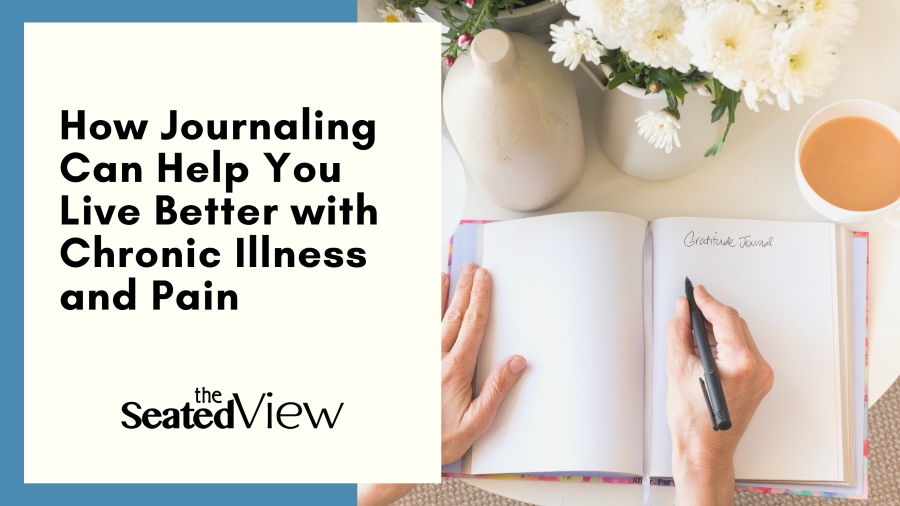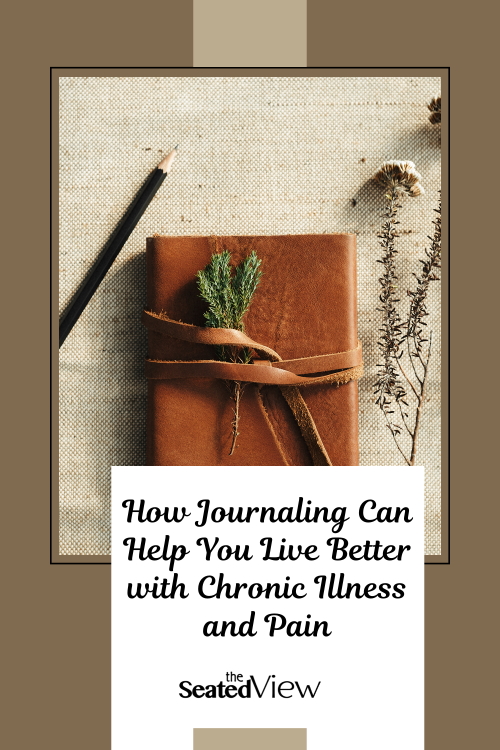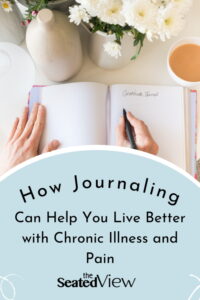How Journaling Can Help You Live Better with Chronic Illness and Pain

Did you know journaling can be an important tool to add to your bag of chronic illness and pain coping tools? It’s been shown to help people cope with pain, PTSD, depression, and even have a beneficial effect on your immune system. This is the first in a series on journaling and chronic illness and today, I’m taking a look at the research, share tips on how to get started, and include journaling prompts to get you started.
Posts in this series:
Part One – How Journaling Can Help You Live Better with Chronic Illness and Pain
Part Two — Journaling with Chronic Illness: My Favourite Supplies
Part Three — Journaling with Chronic Illness: Tracking Your Life
Part Four — Journaling with Chronic Illness: Finding Inspiration for Creativity
The facts on journaling and chronic illness
There are a host of studies on the impact of journaling on chronic illness, chronic pain, trauma, and depression. In this context, it’s often described as narrative therapy or expressive writing and is so established that there is even a professional publication called the International Journal of Narrative Therapy and Community Work. It is usually done in response to a prompt and you are encouraged to write freely, keeping the pen moving across the pain undeterred by your inner editor. The studies show that spending time writing for about 20-30 minutes (depending on your ability) about a particular issue related to your condition can have a significant benefit for people with medical conditions. Not only can this help you not deteriorate, but also actually improve how you cope with pain, your experience of pain, and may even have an impact on your physical health, including improving physiological factors within your immune system.
All this without a prescription!
Using writing effectively isn’t just about venting for 20 minutes. Writing prompts can help you think deeper on the topic and be useful to help you process what happening and how you feel, eventually come to a better relationship with your symptoms.
Finding a narrative therapy group can be a little more challenging, but you may be able to get started on your own. Keep in mind that it’s important to not just focus on negative or traumatic aspects of your life and symptoms as this can leave you feeling raw and even more upset. Instead, it’s important to write with the intention to process how you feel, as well as selecting both negative and positive emotions and events to write about at different times. Being focused in both thought and emotion can mean your efforts are more likely to be constructive.
If you’re dealing with significant issues or discover that this kind of writing makes you feel worse, upset, or depressed, please seek out the help of a professional to guide you safely through the exploration. Talk to your doctor or look for a therapist via the search function on the Psychology Today website.

Journaling is about more than therapy
Journaling has been an important part of my life at various times, starting at a very young age — back then, we called it writing in your diary. Working things out in a notebook helped me get through some very difficult times and it was my daily companion for many years. And then I stopped. Partly because I was happier in my life, but also because my Big Flare meant writing by hand for extended periods of time was difficult. Increasingly, I moved my writing and planning to a digital format, even when years later my partner started a tradition of buying me a Hobonichi Techo planner every Christmas — it’s a wonderful Japanese brand that’s known for its thin but very fountain pen friendly paper and flexibility of use.
And then came the pandemic. At some point, I started messing about in my Techo, while watching YouTube videos about planning and then following people sharing beautiful photos and… Well, perhaps it was inevitable. I’ve always been a stationary nerd.
These days, I use my planner and collection of notebooks for a variety of purposes. Course notes go in one notebook, notes about the book I’m writing go in another, and my Techo is used to keep track of my life. Summaries from doctor’s appointments, dates for ordering and picking up medication, writing a short review about a book I just finished, favourite memory, tracking my monthly 3 Things, writing down my daily gratitude list and so much more. Those 20 minutes a day of playing with paper and pens is valuable quiet time that bring peace to my soul.
Over the next several weeks, I’ll dive deeper into specific aspects of journaling and the many fun things you can do with it, but today, I’ll include the basics on how to get started.
At its core it’s about using notebook and a pen. If your condition means you can’t use your hands in this way, typing or dictating works just as well. Even if you can only usually hands a little bit, there is something about that creative hands-on process that is very satisfying.
You can get some very inexpensive supplies pretty much anywhere, but… Finding something that feels just a bit delicious (within your budget) can make the process even more enjoyable, which means you’re more likely to actually sit down and do it. Experimenting a bit with the different types of notebooks and pens may help you find something to write more comfortably.
Pick a notebook that works for you
There are a million different styles of notebooks — different sizes, different types of paper, different style (lined, dotted, blank, graph), soft or hardcover, expensive or cheap and that’s just a few of the different factors. You may already know you favourite kind of notebook, but it’s always fun to check out other styles — who knows, you might find something that works even better. Personally, I never saw the need for anything other than a lined notebook. That is, until this year. Now I don’t like lines at all — instead, I lean towards dots or graph, as long as it’s very lightly printed. There when I needed, light enough to ignore it when I don’t — it gives me more flexibility.
If your hands (fingers, elbows, shoulders) make handling a notebook difficult, try different sizes — personally, I’m big fan of the B6 and A6 sizes (each page approximatel;y the size of a 4×6 or 5×7 photograph). They are relatively small, which means I don’t have to reach and hurt my shoulder in process. As well, I like anything spiral-bound that can be flipped inside out, taking up less room.
Take a wander around a bookshop or stationery store (or a digital trip on the website) to look at all the different notebooks and see what speaks to you. You can also check out my post for next week on my favourite supplies, including notebooks.
Don’t miss a thing! Sign up for email notifications of my new posts in the right-hand sidebar.
How to pick the best pen for you
Years ago, I discovered the Zebra Sarasa gel pen and until very recently, never used anything else. I reached the point in my RA that writing with a ballpoint pen hurts — even if it slight, you still have to press the pen to the paper. Writing is easier when the pen just glides across the page and like me, many in the arthritis community our big fans of gel pens. Of course, you can also try ballpoint pens, roller balls — somewhere between ballpoint and gel pens — pencils, or markers. Even crayons will do in a pinch.
If you have arthritis or another condition that affects your fingers and hands, regular pens may be too thin for a comfortable grip. Buying a collection of pen grips can make that easier — these are little rubber or silicone doodads that you play so your pen, and widening the grip. You can also find special arthritis-friendly pens so you can write without pain. Some are simply much wider than a regular pen, others are designed to be held differently.
Once you have your basic supplies, set aside a bit of time every day — or most days, there are no rules — spend some time with your thoughts and feelings. I’ve shared some journaling prompts below or you can doodle, write about the book you’re reading, you favourite TV show, or the funny thing your kids said.
This is your journal, you can use it any way you want.
7 chronic illness journaling prompts
Journal prompts abound on the Internet — a quick Google search will take you to lots of links. Or you can try the seven prompts I included below, to get you through your first week. I’ll be working on expanding the collection and sharing it at a later date.
- What can you do today to support your body’s ability to carry you through the day? (or the next day, if you’re journaling in the evening)
- What are some of the things that help you get relief from stress and anxiety?
- Imagine creating a safe space for yourself. What does it look, smell, and sound like?
- Create a list of 5-10 songs that make you feel good.
- What are some of the things that you feel guilty about because of your chronic illness? Are there other ways of achieving what you want?
- What are some of the ways you can reduce stress?
- Create a list of all the tools you use to manage pain.
I’d love to hear more about your experience with journaling in the past or what you’d like to get out of it now. And you may want to join my live chat tomorrow, August 19, 2021, at 2:30 PM ET on my Facebook page to talk more about journaling with chronic illness.


Check My Sources
Brown, C. A., Dick, B. D., & Berry, R. (n.d.). How do you write pain? A preliminary study of narrative therapy for people with chronic pain. Diversity & Equity in health and Care.
Glass, O., Dreusicke, M., Evans, J., Bechard, E., & Wolever, R. Q. (2019). Expressive writing to improve resilience to trauma: A clinical feasibility trial. Complementary Therapies in Clinical Practice, 34, 240–246. https://doi.org/10.1016/j.ctcp.2018.12.005
Murray, B. (2002). Writing to heal. Monitor on Psychology. https://www.apa.org/monitor/jun02/writing.
Phillips, Laurel. (2017). Narrative therapy approach to dealing with chronic pain. International Journal of Narrative Therapy & Community Work, No. 1, 2017: 21-30.
1 Comment
Read More
Discover what else I've been writing about...
















I have never really journaled. I do, however, understand the cathartic experience of writing. I am not an especially good writer, but I like to work at it. You know, someday there may be a book in there somewhere. When I start at a blank screen, I always start with dear Rick. Then I start with what I had seen or done today. It takes a bit, but I get there, and most days, it is not very good. But every once in a great while, I get it right, and when I do, it is special. I have one up now that I especially like.